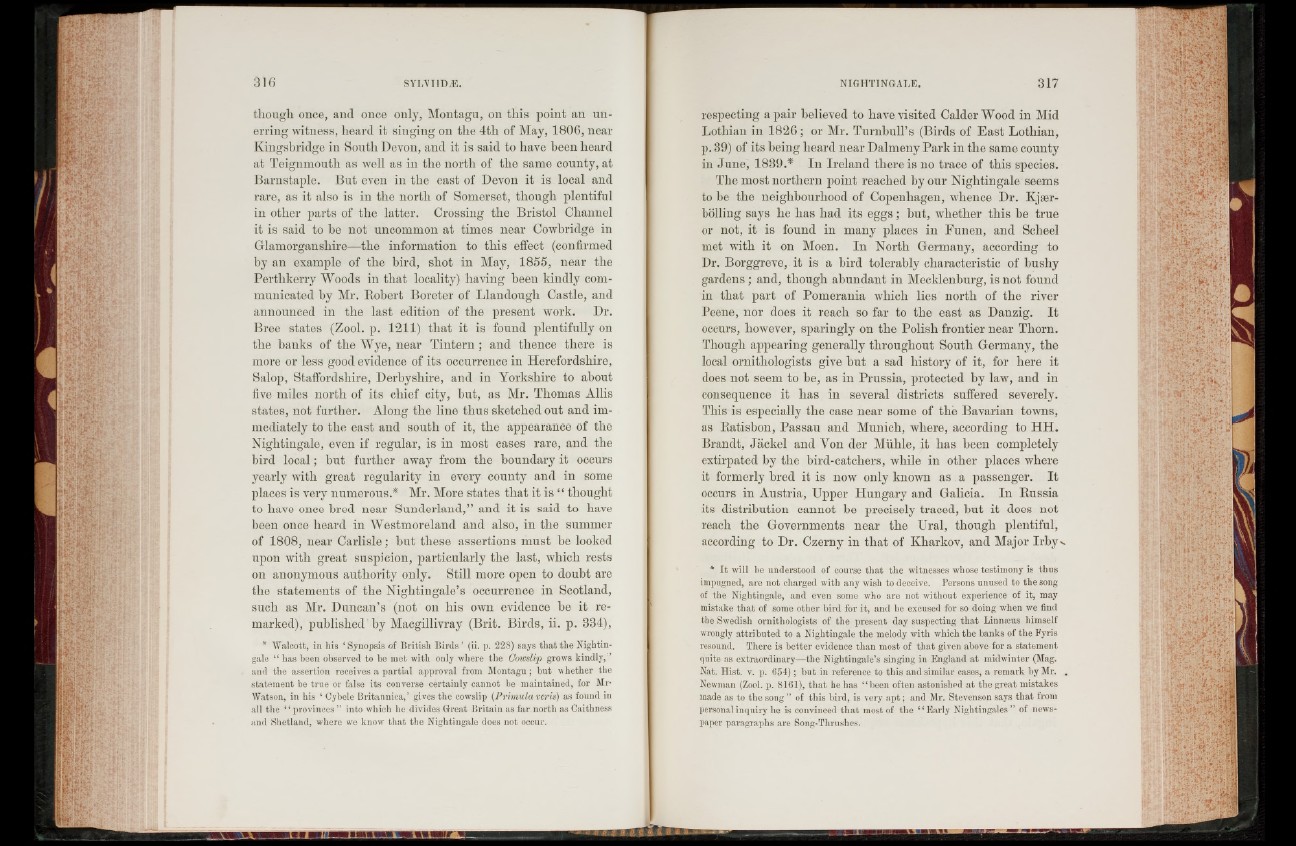
though once, and once only, Montagu, on this point an unerring
witness, heard it singing on the 4tli of May, 1806, near
Kingsbridge in South Devon, and it is said to have been heard
at Teignmouth as well as in the north of the same county, at
Barnstaple. But even in the east of Devon it is local and
rare, as it also is in the north of Somerset, though plentiful
in other parts of the latter. Crossing the Bristol Channel
it is said to he not uncommon at times near Cowbridge in
Glamorganshire—the information to this effect (confirmed
by an example of the bird, shot in May, 1855, near the
Perthkerry Woods in that locality) having been kindly communicated
by Mr. Robert Boreter of Llandough Castle, and
announced in the last edition of the present work. Dr.
Bree states (Zool. p. 1211) that it is found plentifully on
the banks of the Wye, near Tintern ; and thence there is
more or less good evidence of its occurrence in Herefordshire,
Salop, Staffordshire, Derbyshire, and in Yorkshire to about
five miles north of its chief city, but, as Mr. Thomas Allis
states, not further. Along the line thus sketched out and immediately
to the east and south of it, the appearance of the
Nightingale, even if regular, is in most cases rare, and the
bird local; but further away from the boundary it occurs
yearly with great regularity in every county and in some
places is very numerous.* Mr. More states that it is “ thought
to have once bred near Sunderland,” and it is said to have
been once heard in Westmoreland and also, in the summer
of 1808, near Carlisle; hut these assertions must he looked
upon with great suspicion, particularly the last, which rests
on anonymous authority only. Still more open to doubt are
the statements of the Nightingale’s occurrence in Scotland,
such as Mr. Duncan’s (not on his own evidence be it remarked),
published by Macgillivray (Brit. Birds, ii. p. 334),
* Walcott, in his ‘ Synopsis of British Birds ’ (ii. p. 228) says that the Nightingale
“ has been observed to be met with only where the Cowslip grows kindly, ’
and the assertion receives a partial approval from Montagu; but vhether the
statement be true or false its converse certainly cannot be maintained, for Mr*
Watson, in his ‘ Gybele Britannica,’ gives the cowslip (Primula ver is) as found in
all the “ provinces ” into which he divides Great Britain as far north as Caithness
and Shetland, where we know that the Nightingale does not occur.
respecting a pair believed to have visited CalderWood in Mid
Lothian in 1826; or Mr. Turnbull’s (Birds of East Lothian,
p. 39) of its being heard near Dalmeny Park in the same county
in June, 1839.* In Ireland there is no trace of this species.
The most northern point reached by our Nightingale seems
to he the neighbourhood of Copenhagen, whence Dr. Kjser-
bolling says he has had its eggs; but, whether this be true
or not, it is found in many places in Funen, and Scheel
met with it on Moen. In North Germany, according to
Dr. Borggreve, it is a bird tolerably characteristic of bushy
gardens; and, though abundant in Mecklenburg, is not found
in that part of Pomerania which lies north of the river
Peene, nor does it reach so far to the east as Danzig. It
occurs, however, sparingly on the Polish frontier near Thorn.
Though appearing generally throughout South Germany, the
local ornithologists give hut a sad history of it, for here it
does not seem to he, as in Prussia, protected by law, and in
consequence it has in several districts suffered severely.
This is especially the case near some of the Bavarian towns,
as Ratisbon, Passau and Munich, where, according to HH.
Brandt, Jackel and Von der Miihle, it has been completely
extirpated by the bird-catchers, while in other places where
it formerly bred it is now only known as a passenger. I t
occurs in Austria, Upper Hungary and Galicia. In Russia
its distribution cannot he precisely traced, hut it does not
reach the Governments near the Ural, though plentiful,
according to Dr. Czerny in that of Kharkov, and Major Irby's
* I t will be understood of course that the witnesses whose testimony is thus
impugned, are not charged with any wish to deceive. Persons unused to the song
of the Nightingale, and even some who are not without experience of it, may
mistake that of some other bird for it, and be excused for so doing when we find
the Swedish ornithologists of the present day suspecting that Linmeus himself
wrongly attributed to a Nightingale the melody with which the banks of the Fyris
resound. There is better evidence than most of that given above for a statement
quite as extraordinary—the Nightingale’s singing in England at midwinter (Mag.
Nat. Hist. v. p. 654); but in reference to this and similar cases, a remark by Mr. .
Newman (Zool. p. 8161), that he has “ been often astonished at the great mistakes
made as to the song ” of this bird, is very a p t; and Mr. Stevenson says that from
personal inquiry lie is convinced that most of the “ Early Nightingales” of newspaper
paragraphs are Song-Thrushes.